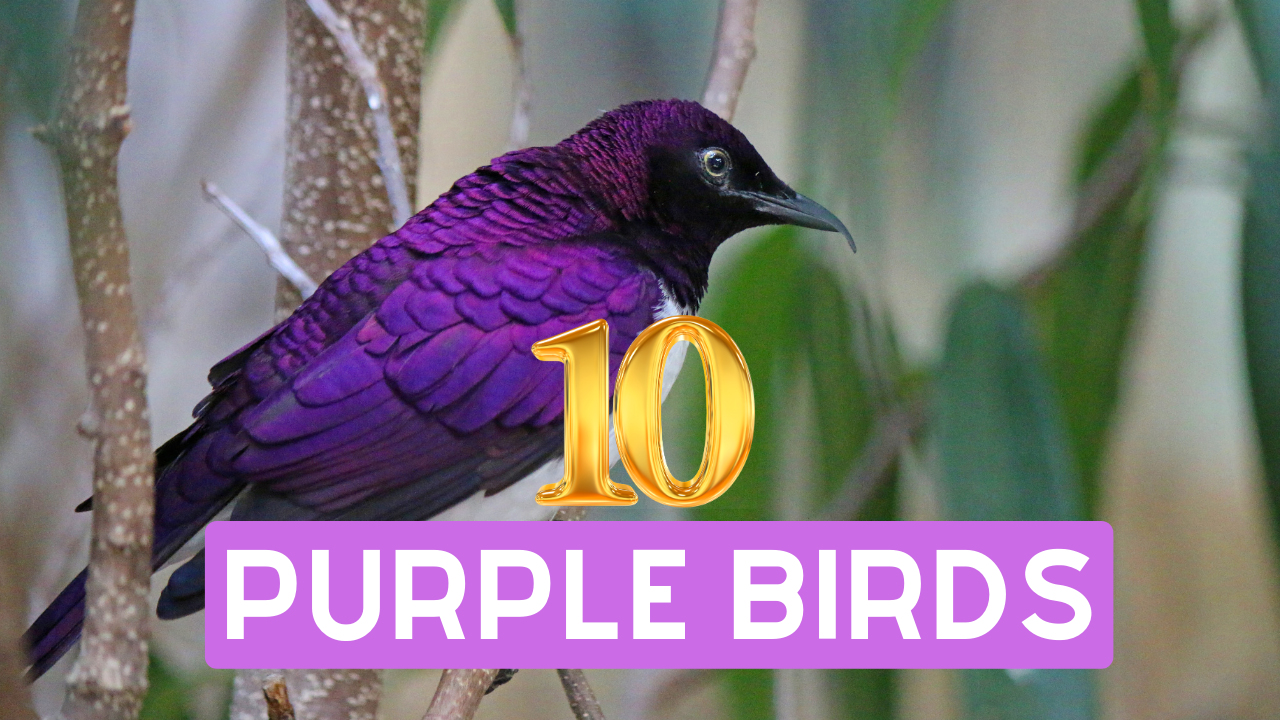We use affiliate links to run our site. When you buy through links on our site, we may earn an affiliate commission, without any added cost to you. Learn more
Purple birds are a fascinating and enchanting group of creatures that capture our imagination with their vibrant plumage. They stand out from the crowd with their striking shades of purple, ranging from deep indigo to soft lilac, and their intricate feather patterns that are truly mesmerizing.
But beyond their beauty lies a deeper significance, as birds play a crucial role in maintaining the delicate balance of our ecosystem. From pollination to pest control, their contributions are essential for the health of our planet.
In this article, we will explore the unique features and interesting facts About these amazing purple birds.
Join us on a journey through the world of purple birds and discover the wonders of these stunning creatures and the important role they play in nature.
Top 10 Purple Birds
1. Purple Gallinule
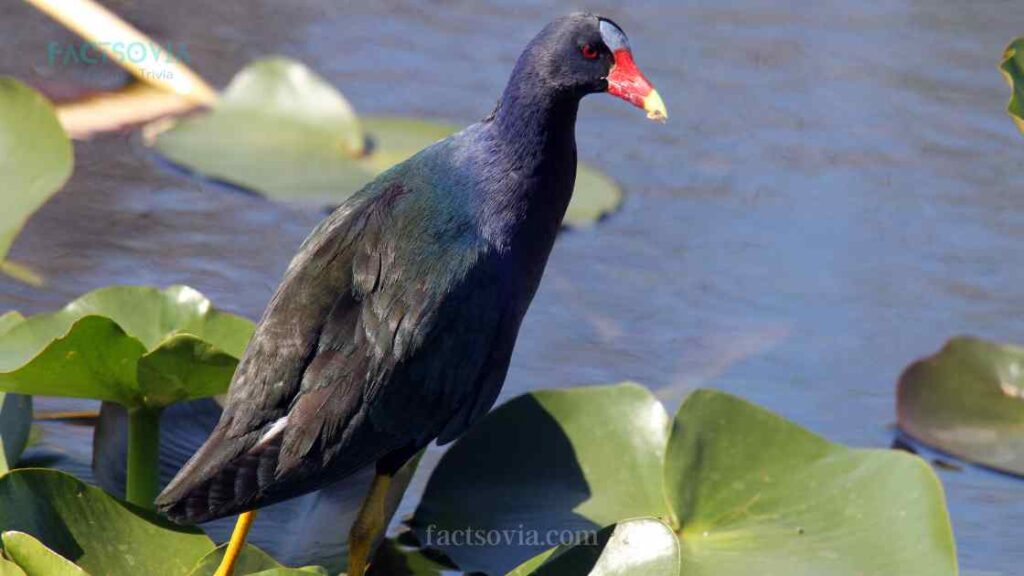
The Purple Gallinule is a vibrant bird with striking purple-blue feathers, green and yellow markings on its head, and a red beak. Its unique features include long toes and long legs that allow it to walk on floating vegetation in the water. This bird is approximately 12-15 inches in length and can weigh up to 7.4 ounces.
Where Will You Find Them:
The Purple Gallinule is found in freshwater wetlands such as swamps, marshes, and ponds in the southeastern United States, Central, and South America. They can also be found in the Caribbean and Africa.
Some Interesting Facts About The Bird:
– The Purple Gallinule has a distinctive call that sounds like “pik-a-pik-a-dow-dow.”
– They are omnivorous and feed on insects, seeds, fruits, and aquatic vegetation.
– These birds are known for their brightly colored and striking plumage, which they use to attract mates.
– Purple Gallinules are excellent swimmers and can even dive underwater to escape predators.
2. Violet-crowned Woodnymph
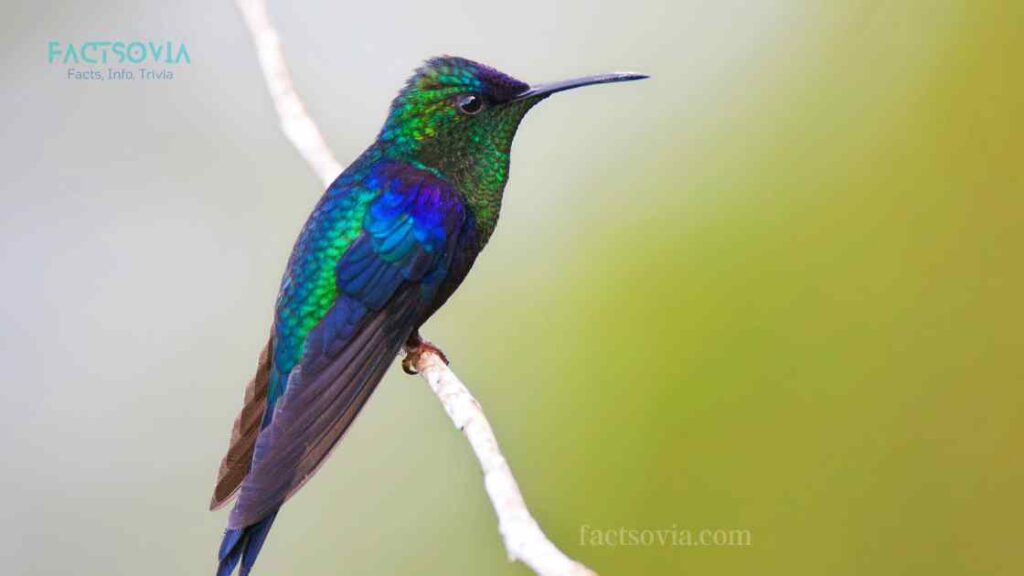
The Violet-crowned Woodnymph is a small hummingbird found in the tropical forests of Central and South America. This bird has iridescent violet-blue feathers on its crown, bright green feathers on its back, and a white breast. Males have a longer tails than females.
Violet-crowned Woodnymphs have a curved beak that is adapted for feeding on nectar. They are About 4 inches in length and weigh About 0.2 ounces. These birds have a distinctive buzzing sound that is made by their rapidly beating wings.
Where Will You Find Them:
They are found in the rainforests, wooded areas, and gardens of Central and South America, ranging from Panama to Bolivia.
Some Interesting Facts About The Bird
– Violet-crowned Woodnymphs are known for their aerial acrobatics, which they use to defend their territory and attract mates.
– These hummingbirds have a high metabolic rate, and their heart rate can reach up to 1,200 beats per minute.
– They are important pollinators of many plants in their habitat.
– In some cultures, these birds are considered symbols of love and beauty.
3. Purple Finch

The Purple Finch is a medium-sized bird found in North America. Males have a bright purple-red head, breast, and back, while females have a brownish-gray head and streaked breast. Both have a distinctive conical beak that is adapted for eating seeds.
Purple Finches are About 6 inches in length and weigh About 0.9 ounces. They have short wings and a forked tail, which allows for quick and agile flight.
Where Will You Find Them:
They are found in coniferous and mixed forests, as well as in suburban areas across North America.
Some Interesting Facts About The Bird
– Purple Finches are known for their beautiful and melodic songs, which they use to attract mates.
– They are social birds and often feed in flocks during the winter months.
– These birds are seed-eaters and are particularly fond of sunflower seeds.
– Purple Finches have declined in numbers due to habitat loss and competition with House Finches.
4. Purple Honeycreeper
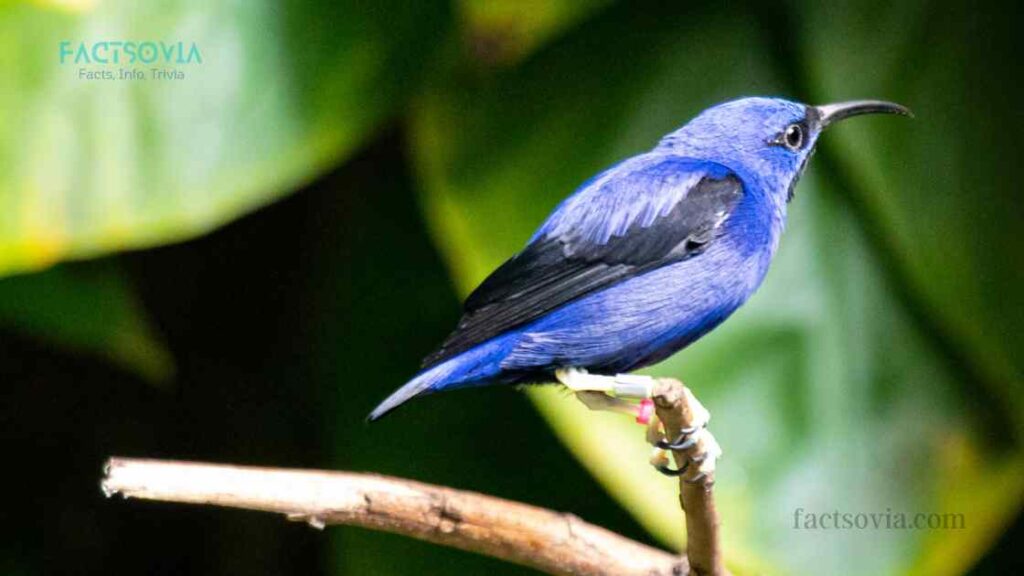
The Purple Honeycreeper is a small bird found in the tropical forests of Central and South America. Males have a bright blue-purple body, while females have a greenish-blue body with a purple head.
They have a curved beak that is adapted for feeding on fruit and nectar. Their wings and tail are short, and they have strong legs and feet for perching. Purple Honeycreepers are About 4 inches in length and weigh About 0.3 ounces.
Where Will You Find Them:
They are found in the canopy of tropical forests in Central and South America, from Mexico to Brazil.
Some Interesting Facts About The Bird
– Male Purple Honeycreepers have a unique courtship display, where they spread their wings and flutter in front of females.
– They are important pollinators of many plants in their habitat.
– These birds are often seen in mixed flocks with other species of birds.
– Purple Honeycreepers are sometimes kept as pets because of their striking colors.
5. Purple Sunbird
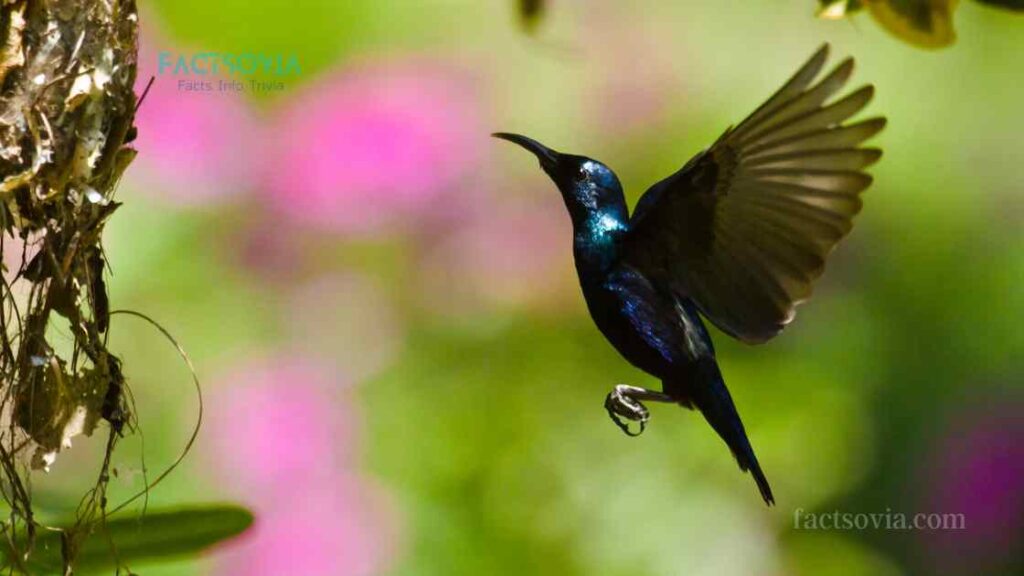
The Purple Sunbird is a small bird found in Asia. Males have a metallic purple-blue head, back, and breast, while females have a duller greenish-yellow color.
They have a long, curved beak that is adapted for feeding on nectar and insects. Purple Sunbirds are About 4 inches in length and weigh About 0.2 ounces.
Where Will You Find Them:
They are found in gardens, parks, and forests across Asia, from the Indian subcontinent to Southeast Asia.
Some Interesting Facts About The Bird
– These birds are highly territorial and defend their feeding and breeding areas aggressively.
– They are important pollinators of many plants in their habitat.
– Purple Sunbirds are known for their acrobatic flight and their ability to hover while feeding.
– In some cultures, these birds are considered symbols of good luck and prosperity.
6. Purple Swamphen
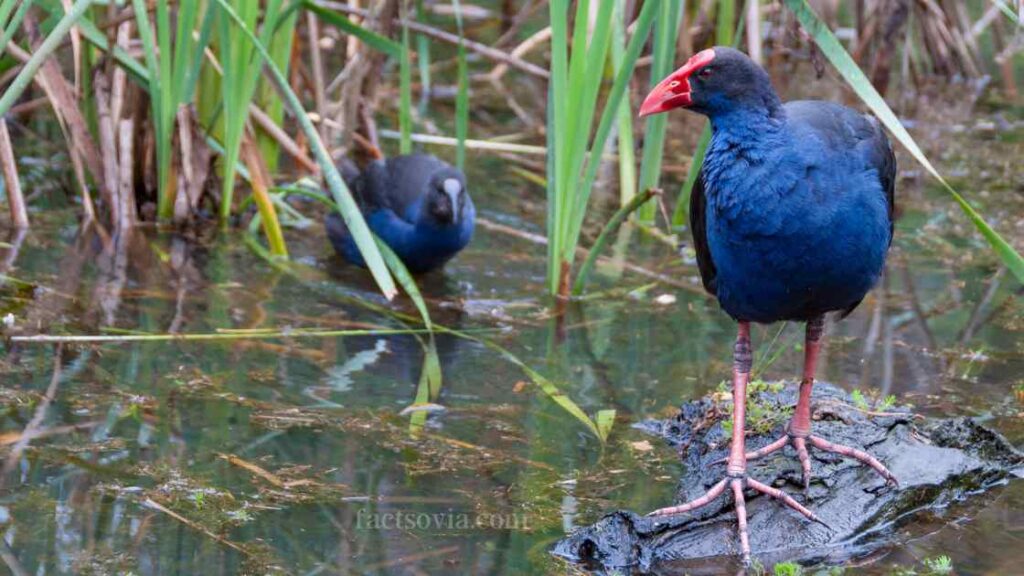
The Purple Swamphen is a large bird found in the wetlands of Australia, Asia, and Africa. They have a dark blue-purple body, red beak, and long legs.
They have a distinctive red forehead shield that extends from their beak to their head. Purple Swamphens are About 15-20 inches in length and weigh About 1.4 pounds.
Where Will You Find Them:
They are found in wetlands such as swamps, marshes, and ponds across Australia, Asia, and Africa.
Some Interesting Facts About The Bird
– Purple Swamphens are omnivorous and feed on a variety of foods, including plants, insects, and small animals.
– They are excellent swimmers and are often seen wading in shallow water.
– These birds have a loud and distinctive call that sounds like “squark.”
– In some cultures, they are considered a pest because of their destructive feeding habits.
7. Purple Martin
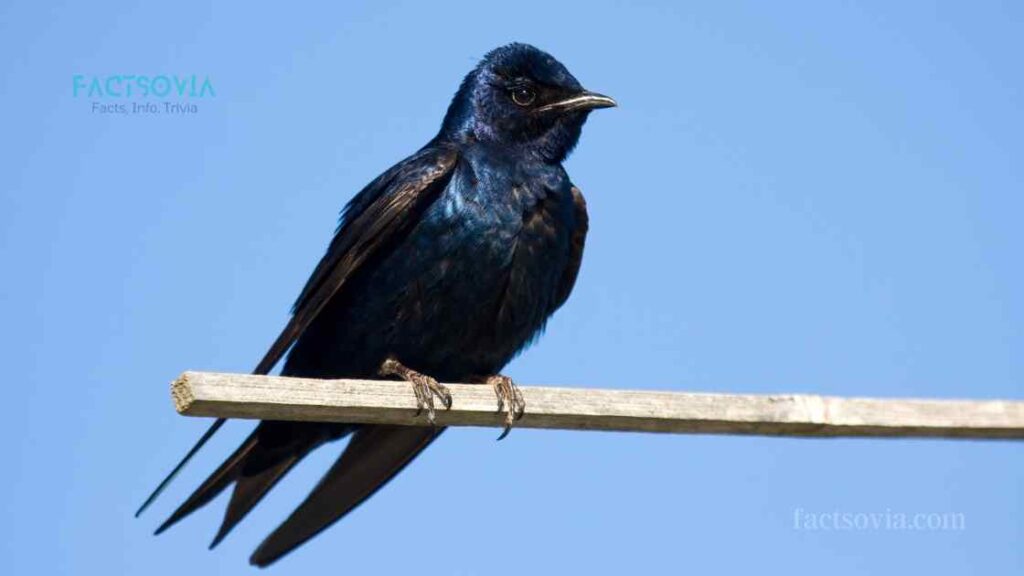
The Purple Martin is a medium-sized bird found in North America. Males have a dark purple-blue body, while females have a lighter brownish-purple body.
They have a distinctive forked tail, long wings, and a broad beak that is adapted for catching insects in mid-air. Purple Martins are About 7 inches in length and weigh About 1.8 ounces.
Where Will You Find Them:
They are found in open areas such as fields, meadows, and near water across North America.
Some Interesting Facts About The Bird
1. Purple Martins are the largest member of the swallow family in North America. They are also one of the few bird species in North America that rely almost entirely on human-made housing for nesting.
2. Purple Martins are migratory birds that spend their winters in South America and breed in North America during the summer months. They typically arrive in the southern US in late winter and early spring and can be seen as far north as Canada by early summer.
3. Male Purple Martins have a unique ability to mimic sounds from their environment, including other bird songs, frog calls, and even human speech. They use this skill to attract mates and communicate with other Purple Martins.
4. Purple Martins are social birds and often nest in large colonies. These colonies can consist of hundreds or even thousands of individuals, providing safety in numbers from predators and other threats.
5. Purple Martins are voracious insect eaters, feeding on a wide variety of flying insects such as mosquitoes, flies, and beetles. A single Purple Martin can eat up to 2,000 insects in a day, making them a valuable asset for pest control.
8. Purple Heron
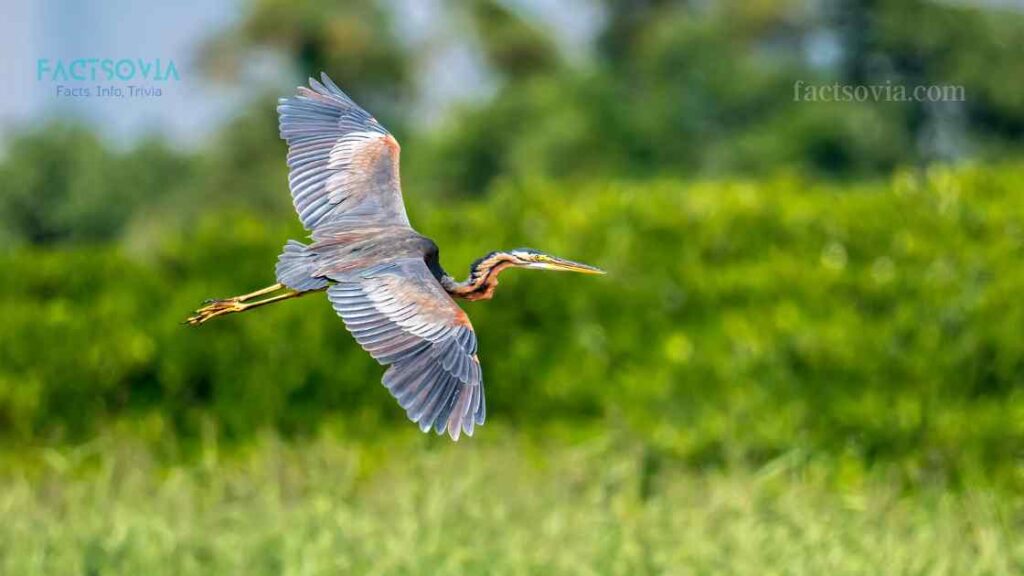
The Purple Heron is a tall, elegant bird with distinctive purple-gray plumage. It is known for its long neck and legs, which allow it to wade in shallow waters while searching for prey. The Purple Heron also has a long, pointed bill that it uses to catch fish, frogs, and other small animals.
Where Will You Find Them:
Purple Herons can be found in wetland areas throughout Europe, Asia, and Africa. They prefer to live in marshes, swamps, and shallow lakes or ponds with dense vegetation.
Some Interesting Facts About The Bird
– The Purple Heron is a solitary bird that is usually seen alone or in pairs.
– During the breeding season, the Purple Heron’s plumage turns a brighter shade of purple.
– The Purple Heron is known for its unique hunting technique, where it uses its wings to create a canopy to shade the water, making it easier to spot prey.
9. Purple Grenadier
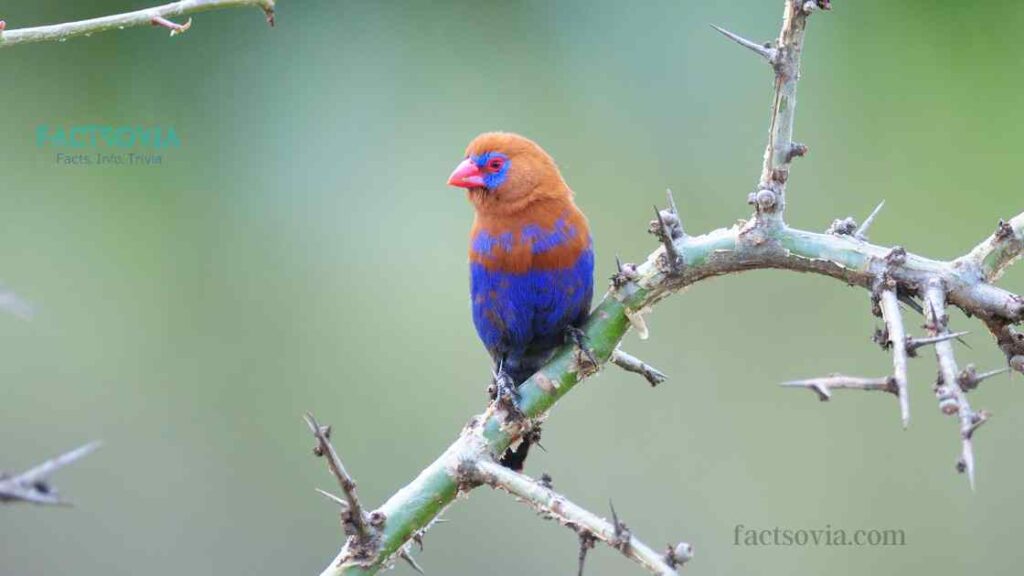
The Purple Grenadier is a small, colorful bird that is native to the forests of Central and South America. It has a bright purple head, back, and wings, with a black tail and bill. The rest of its body is a deep red color.
The Purple Grenadier has a unique, conical bill that it uses to extract seeds from fruits and flowers. It also has a distinctive hopping motion that it uses to move through the branches of trees.
Where Will You Find Them:
Purple Grenadiers can be found in the tropical forests of Central and South America, including Brazil, Peru, and Ecuador. They prefer to live in the canopy of the forest, where they can easily access their food source.
Some Interesting Facts About The Bird
– The Purple Grenadier is known for its beautiful song, which is often used in bird song competitions.
– It is a social bird that is often seen in small groups or flocks.
– The Purple Grenadier’s bright colors are thought to serve as a warning to potential predators.
10. Purple-naped Lory
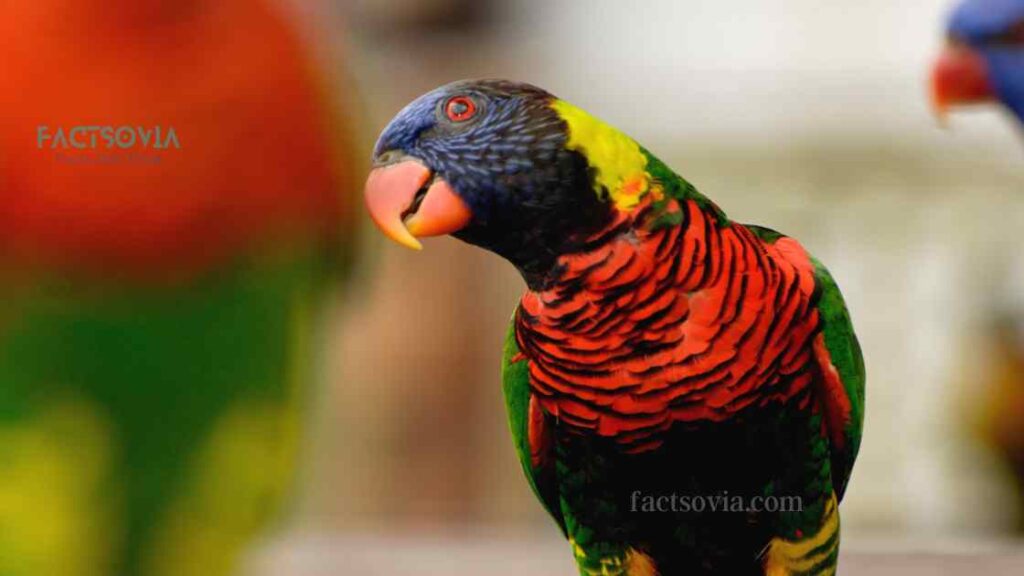
The Purple-naped Lory is a medium-sized parrot that is known for its stunning purple plumage. It has a deep purple head, neck, and breast, with green wings and a red abdomen.
The Purple-naped Lory has a distinctive, curved bill that it uses to extract nectar from flowers. It also has a unique tongue, which is brush-like and helps it to extract pollen from flowers.
Where Will You Find Them:
Purple-naped Lories are native to the rainforests of Indonesia, Papua New Guinea, and the Solomon Islands. They prefer to live in the canopy of the forest, where they can easily access their food source.
Some Interesting Facts About The Bird
– The Purple-naped Lory is known for its playful and curious nature, and it is often kept as a pet.
– It is a social bird that is often seen in pairs or small groups.
– The Purple-naped Lory’s bright colors are thought to help it blend in with the colorful flowers of its habitat.
Frequently Asked Questions(FAQs):
What makes purple birds purple?
The color purple in bird feathers is the result of the way light interacts with the microscopic structure of the feathers. The feathers contain tiny air pockets that reflect and scatter light, creating the purple coloration.
Where can I find purple birds?
Purple birds can be found in various habitats around the world, including forests, grasslands, wetlands, and even urban areas. Some species are only found in specific regions, while others have a more widespread distribution.
Are there any endangered purple bird species?
Yes, there are several endangered purple bird species, including the Bali Myna, the Philippine Eagle, and the Madagascar Pochard. Habitat loss, hunting, and the pet trade are among the main threats to these species.
Do purple birds have any special adaptations?
Some purple bird species have unique adaptations that help them survive in their environments. For example, the Purple-crowned Fairy has a curved bill that is specialized for feeding on nectar from flowers, while the Purple Sandpiper has specialized feet that allow it to grip onto rocky surfaces in its coastal habitat.
What is the symbolism of purple birds in various cultures?
In many cultures, purple birds are associated with royalty, spirituality, and power. For example, in ancient Rome, the purple color was reserved for the clothing of emperors and other high-ranking officials, and purple birds such as the Purple
Gallinules were considered a symbol of wealth and prestige. In Hinduism, the Purple Sunbird is associated with the god of love and beauty, and is believed to bring good luck and prosperity.
Conclusion:
The world of birds is truly fascinating, and purple birds are no exception. From the majestic Purple Gallinule to the charming Purple-naped Lory, each of the ten purple birds we have explored in this post has unique features and characteristics that make them stand out.
Birds are not only a delight to watch but also play an essential role in our ecosystem. They help with pollination, seed dispersal, and insect control, making them crucial to maintaining a healthy environment.
We hope that this post has piqued your interest in the world of birds and encouraged you to learn more about them. We invite you to share this post with your friends and family, so they too can appreciate the beauty of these amazing creatures.
If you enjoyed reading about these purple birds, be sure to explore more articles on our site, where you can find information on a variety of topics related to nature and wildlife.
Finally, we encourage you to take action to protect and preserve the habitats of these beautiful birds and all other creatures that share our planet. Even small actions, such as recycling and reducing plastic use, can have a significant impact on our environment and help ensure a bright future for all living beings.
Amazon and the Amazon logo are trademarks of Amazon.com, Inc, or its affiliates.
